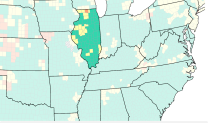One Illinois county has risen to a "high" COVID alert level this week, sparking new masking guidelines and marking a shift after the state had no counties at such a level last week.
Winnebago County, just outside the Chicago area along the Illinois-Wisconsin border, was listed at a "high" community level for COVID by the Centers for Disease Control and Prevention. At a "high" alert level, masking is recommended for all in indoor public spaces.
More than a dozen other counties in Illinois were listed at a "medium" level, meaning those at high risk of illness are urged to wear masks in public indoor spaces.
Notably, several Chicago-area counties that were listed at medium last week, dropped back down to low.

Under CDC recommendations for counties at "medium" risk level, the elderly and immunocompromised are recommended to wear a mask in indoor public places and receive COVID vaccinations and booster shots, if eligible.
Chicago's health department also noted that anyone traveling to counties under a medium or high community level should mask in indoor public spaces.
Local
Once a county reaches a "high" alert level, masking is recommended for all in indoor public spaces.
In addition to COVID, RSV and flu cases are leading to concerns from health experts heading into the holiday season.
Feeling out of the loop? We'll catch you up on the Chicago news you need to know. Sign up for the weekly> Chicago Catch-Up newsletter.
Influenza-like activity is now high in Illinois, according to the Centers for Disease Control and Prevention.
Health officials are urging people to get their COVID boosters and flu shots ahead of the Thanksgiving holiday.
"My concern is as COVID really takes off and as the flu really takes off that it is really going to continue to stretch our hospital capacity," said Dr. Allison Arwady, the public health commissioner for the Chicago Department of Public Health.
The bivalent booster was designed to fight both the original coronavirus and the omicron subvariants BA.4 and BA.5, but new data from the Chicago Department of Public Health shows BA.5 making up only 35% of the cases right now, with other subvariants, including BQ.1 and BQ.1.1 growing.



